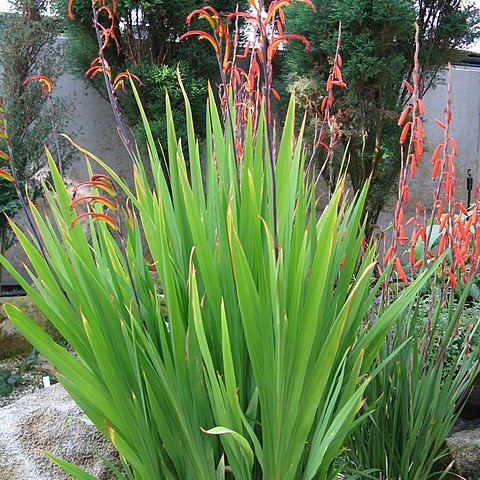Plants 700-900 mm high. Corm lightly depressed-globose, 20-25 mm diam., tunics thin-papery. Stem erect, usually with 1 to 3 short branches, spike strongly drooping in bud and early flowering. Leaves several in a basal fan, sword-shaped, with a prominent main vein, reaching ± base of spike, 17-33 mm wide. Spike erect, 2-ranked, mostly 18-to 28-flowered; bracts with dry tips, 6-10 mm long. Flowers nodding, orange-scarlet, lower lateral tepals green, tube yellow inside, unscented; perianth tube trumpet-shaped, slender below for 6-10 mm, abruptly expanded into a wide, cylindric upper part mostly 20-25 mm long, arching outward and horizontal above; tepals all arising ± at same level, unequal, dorsal largest, 27-40 mm long, spathulate, folded along midline, upper lateral and lowermost tepals directed forward, 5-8 mm long, lower laterals spreading to half-recurved, ± 8 mm long. Filaments 45-60 mm long; anthers 6-7 mm long, median usually exceeding dorsal tepal, purple; pollen purple. Style arching below filaments, dividing opposite middle of anthers, branches ± 3 mm long. Capsules ± ovoid, 3-lobed, showing outline of seeds, 15-20 mm long, smooth. Seeds globose, 2 per locule, 3.5-4.0 mm long, yellowish to orange, coat hard, semi-matte.
More
Corm ± 4 cm wide; tunic papery, light brown, Stems 70-100 cm high. Leaves ± ½ length of stem, to 3 cm wide, midvein slightly prominent. Spike to 25 cm long, many-flowered, occasionally branched at base; spathe-valves brown, membranous. Flowers ± 6 cm long, ± 1 cm diam., upper side scarlet, lower side yellow and green; tube 0.5 cm × 1 mm in lower narrow portion, 2 cm × 5 mm above; upper lobe 3 cm long, obtuse, scarlet, other lobes all acute, c. 5 mm long, with red lobe either side of long lobe, 3 remaining lobes green, narrower. Anthers black, projecting beyond long perianth-lobe. Seeds globose to slightly angled, orange-red, dull.
Cormous geophyte, 70-90 cm, corm tunics papery, stems usually branched. Leaves sword-shaped. Flowers in a second spike, tube flaring gradually, orange-red with green markings.


